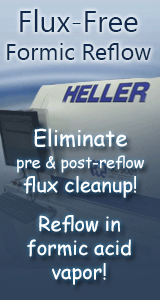Printed Circuit Board Assembly & PCB Design Forum
SMT electronics assembly manufacturing forum.
- SMTnet
- »
- Electronics Forum
- »
- Solder Coverage in Non ROHS Paste
Solder Coverage in Non ROHS Paste
Views: 2833
![]() Hi Everyone, Can you please suggest how to achieve 100% sold...
- Dec 06, 2021
by
jinesh
Hi Everyone, Can you please suggest how to achieve 100% sold...
- Dec 06, 2021
by
jinesh
![]()
![]()
![]() 1 to 1 stencil aperture to pad should be fine on the gull le...
- Dec 06, 2021
by
DWL
1 to 1 stencil aperture to pad should be fine on the gull le...
- Dec 06, 2021
by
DWL
![]()
![]()
![]() What is your current paste coverage? You mentioned windowpan...
- Dec 06, 2021
by
Evtimov
What is your current paste coverage? You mentioned windowpan...
- Dec 06, 2021
by
Evtimov
![]()
![]()
![]() OSP finish is the big issue here. You almost can not get 100...
- Dec 06, 2021
by
DucHoang
OSP finish is the big issue here. You almost can not get 100...
- Dec 06, 2021
by
DucHoang
![]()
![]()
![]() Hi DWL, Thanks for your quick response. Let Me revert back o...
- Dec 07, 2021
by
jinesh
Hi DWL, Thanks for your quick response. Let Me revert back o...
- Dec 07, 2021
by
jinesh
![]()
![]()
![]() Hi Evtimov, Thanks for your response - Coverage of Paste on ...
- Dec 07, 2021
by
jinesh
Hi Evtimov, Thanks for your response - Coverage of Paste on ...
- Dec 07, 2021
by
jinesh
![]()
![]()
![]() Hi DucHoang, Thanks for your response - Understanding that ...
- Dec 07, 2021
by
jinesh
Hi DucHoang, Thanks for your response - Understanding that ...
- Dec 07, 2021
by
jinesh
![]()
![]()
![]() Hello Jinesh , if you can provide us with component datashee...
- Dec 07, 2021
by
Djo
Hello Jinesh , if you can provide us with component datashee...
- Dec 07, 2021
by
Djo
![]()
![]()
![]() How fast do you use your OSP boards?
We don't use them but i...
- Dec 07, 2021
by
Stephen
How fast do you use your OSP boards?
We don't use them but i...
- Dec 07, 2021
by
Stephen
![]()
![]()
![]() You likely have raised belly pads. If possible, do a step-u...
- Dec 21, 2021
by
jseewald
You likely have raised belly pads. If possible, do a step-u...
- Dec 21, 2021
by
jseewald
![]()
![]()
![]() Hi JSeewald, You are very much right that there is differenc...
- Dec 27, 2021
by
jinesh
Hi JSeewald, You are very much right that there is differenc...
- Dec 27, 2021
by
jinesh
![]()
![]()
![]() Hi Stephen, Thanks for your response. Since the OSP Finished...
- Dec 27, 2021
by
jinesh
Hi Stephen, Thanks for your response. Since the OSP Finished...
- Dec 27, 2021
by
jinesh
![]()
![]()
![]() Hi Djo, very much sorry to say that no gbx file is available...
- Dec 27, 2021
by
jinesh
Hi Djo, very much sorry to say that no gbx file is available...
- Dec 27, 2021
by
jinesh
![]()
![]()
![]() Sharing you datasheet FYR
...
- Dec 27, 2021
by
jinesh
Sharing you datasheet FYR
...
- Dec 27, 2021
by
jinesh
![]()
- SMTnet
- »
- Electronics Forum
- »
- Solder Coverage in Non ROHS Paste







